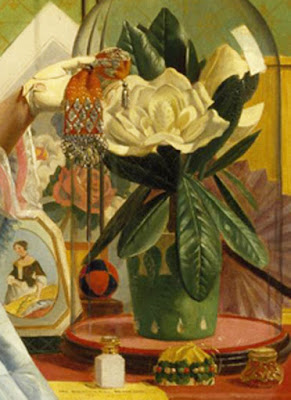Women selling needlework in the New Jersey booth at an 1864
fundraising fair in New York City
Some questions this blog hopes to answer:
1. How long have people been selling patchwork patterns?
2. How long have people been selling quilt kits?
3. How long have women been making a living supplying needleworkers?
The answers are probably all the same: As long as people have been stitching patchwork and quilts.
A reference to buying a paper quilt pattern in 1835 from a Delaware woman:
Phoebe bought her pattern card at a charity bazaaar, a typical place (then and now)
for women to exchange needlework.
The Empty Purse by James Collinson, about 1850.
Tate Museum Collection.
Painting with a moral of an English woman at a church fair at St. Bride's Church in Lonodn.
St. Bride's
Being a Pre-Rafaelite, Collinson painted everything
in great detail. Notice the ball pincushion.
It's hard to figure out Collinson's moral but we get a view of the kinds of needlework and paper items available at charity fairs on either side of the Atlantic.
Patterns also were available from commercial establishments in London. One entrepreneur was Emma Elizabeth Keytes Wilcockson (1829-1871) who operated a Fancy Repository with her husband Herbert near Tottenham Court Road in the 1850s & '60s. Her primary business seems to have been marking for embroidery. By 1856 she noted: " I have issued from my establishment upwards of 60,000 square yards of traced and perforated muslin for embroidery.”
Englishwoman's Domestic Magazine April, 1865
Dagmar Star (perhaps named for Princess
Alexandra's sister who
married the heir to the Russian throne in 1866)
Mrs. Wilcockson also sold patterns for patchwork.
A feature in an 1865 ladies' magazine showing the Dagmar Star advised readers:
"Mrs. Wilcockson....supplies pieces of patchwork arranged in this pattern, as well as pieces of stiff paper or cardboard ready cut, and silk for completing the work. The pieces may be obtained at her establishment."
You could buy a pre-cut kit for the star or paper templates with silk to cut yourself.
The neighborhood on Tottenham Court Road.
The shop was at 44 Goodge Street and later 46, both buildings gone.
Emma and Herbert Wilcockson's Fancy Repository was an all-purpose needlework shop selling fabric, thread, marked patterns for embroidery, kits for making what-nots and knicknacks ("smoking caps with the leaves cut out and gummed on the cloth ready for working")
An 1860 advertisement for a free catalog.
She featured "Initial Letters in Twenty Different Styles" to embroider here.
Typical published embroidery pattern
Emma explained how to use her paper patterns:
"Trace your pattern on tissue paper. Ink over the design, and when dry tack the paper on the material ...when finished tear the paper away. "
Husband Herbert (1827-?) was a solicitor, a printer and a publisher. While working as a lawyer he was also proprietor of the Repository, although this may have been a legal nicety and Emma was the actual proprietor. In 1857 she published a book Embroidery: Its History, Beauty, and Utility: With plain instructions to learners (Darton & Company, Holborn Hill). I haven't been able to find a digital copy of this book or her catalogs.
1861 ad in Mrs. Beeton's magazine on household management.
Emma Wilcockson was skillful at using print to promote her pattern business. She had regular features in the Englishwoman's Domestic Magazine and advertisements (hard to distinguish between the two) in other periodicals.
"Ladies and the Trade supplied with the Newest Designs. Better Materials than any other House, at Mrs. Wilcockson's, 44, Goodge-street, Tottenham-Court-road, London"Emma and Herbert had five children to support. Annie, Frank (born about 1856) and Ernest are three of them.
The Sandringham Patchwork Pattern,
published by the Domestic Magazine in 1863.
Sandringham was the home of the Prince of Wales &
Alexandra who married in 1863.
20th-century Pennsylvania version of
Sandringham in velvet from Stella Rubin's shop
"Herbert Wilcockson...Printer, Manager of the business of a Printer, and
Dealer in Berlin Wool and Fancy Goods...has been adjudged bankrupt."
Unfulfilled orders had been piling up.
In 1866 the Domestic Magazine announced they were severing their connection with Emma Wilcockson due to "numerous complaints."
Like the Wilcocksons, Domestic Magazine publishers Samuel &
Isabella Beeton were a husband/wife publishing team, but far more successful.
Their Domestic Magazine published patterns for clothing and
fancy work from 1856 to 1879.
Emma is found in the 1871 British census. She apparently died that year at 42. I'd like to know more about her and her Fancy Repository. And:
Were there similar establishments in the U.S. in the 1860s?
A Fancy Repository in Durham, England about 1905.
Needlework in the right hand window.


















Is the Dagmar Star pattern in BlockBase? I could not locate it. Perhaps by another name?
ReplyDeleteDagmar Star not in BlockBase. I should draw a pattern.
ReplyDeleteHello, as a direct descendant of Emma and Herbert Wilcockson, I was fascinated by this article and want to convey my thanks for it. I wonder if it would be possible to learn what source was used for the research on Emma and her quotes etc. .so that I may learn more.
ReplyDeleteThanks so much.
Sue Thomas
We have found the book Emma wrote : https://books.google.co.uk/books?id=wgw2mQEACAAJ&printsec=frontcover&source=gbs_ge_summary_r&cad=0&fbclid=IwAR2ozXWKfpPelYpfcRHa8LdkxHlClsPfv-xcxFAbXwATrR2rxE_IGHPcpaQ#v=onepage&q&f=true
ReplyDelete